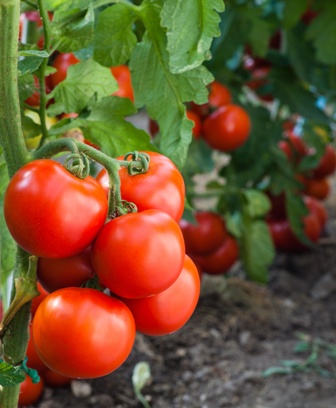Cropland may contain large quantities of metal and metalloid contaminants as a result of the use made of the soil. A UPV/EHU research group has studied the proportion in which these contaminants reach the crops we eat. To do this, the concentration of metal and metalloids in the soil on various Basque locations was studied, and so was the correlation between this concentration of contaminants and its content in tomatoes grown in these locations.
Metal contaminants in cropland do not reach tomatoes
A study by the UPV/EHU-University of the Basque Country has concluded that the quantity of toxic metals found in vegetables in the Basque Autonomous Community is below the maximum allowed by European legislation
First publication date: 25/02/2015

The intensive use of agrochemical substances has significantly increased contamination of cropland by metals. In the Basque Country vegetables are the third group of most consumed food, after fruit, milk and dairy products. The most consumed vegetable is the tomato (about 60 g per day per person is eaten). So consuming tomatoes that have relatively high concentrations of contaminants could be harmful for human health. It should be remembered that the absorption of metals and metalloids present in cropland is the most significant source of contaminants in plants, tomato plants especially, whereas atmospheric deposition and contamination through irrigation water are secondary sources of contaminants.
The Ibea research group (Ikerkuntza eta Berrikuntza Analitikoa-Analytical Research and Innovation) of the Department of Analytical Chemistry of the UPV/EHU's Faculty of Science and Technology has explored whether a significant correlation actually exists between soil contaminants and the ones in the tomatoes themselves. On the other hand, the risk associated with consuming tomatoes grown in the Basque Country has been estimated on the basis of the recommendations issued by the World Health Organisation and European legislation with respect to the concentrations of metals and metalloids (elements that have properties of metals and non-metals). So soil samples and tomatoes were taken in thirteen locations -twelve in Bizkaia (Orduña, Balmaseda, Getxo, Barrika, Unbe, Arteaga, Zamudio, Lezama, Gamiz, Larrabetzu, Lemoa and Dima), and one in Gipuzkoa (in Donostia-San Sebastian)-, and the concentrations of various metals and metalloids in them were analysed.
Levels below the maximum concentration permitted by legislation
As the research group expected, it was in the soil analysed in the Donostia-San Sebastian location where lead and zinc concentrations above the permitted limits were found due to the fact that the area is affected by old mining activities. As regards the rest of the elements analysed in the soil in all the locations, they were found in concentrations below the permitted maximum limit, and the concentrations found in tomato samples were much lower than those found in other contaminated areas of the world.
It is worth noting that it was in the Zamudio location that the highest concentration of copper in tomatoes was found. But bearing in mind the average daily tomato consumption per person and the relatively low toxicity of copper, this level does not endanger human health, as it accounts for 0.5% of the daily consumption recommended by the WHO (World Health Organisation).
In any case, the researchers concluded that there is no direct correlation between the metal content of the soil and the tomatoes. Tomato plants grown in soils containing high concentrations of metals do not necessarily have a high content of contaminants in their fruit; in other words, the presence of these elements in cropland does not imply that they are accumulated in the edible part of the plant. There is just one exception: manganese. Tomatoes from manganese-rich cropland have a large quantity of manganese, which indicates that not only the absorption of this metal in the roots but also the transport mechanism from the roots to the crops themselves are efficient in tomato plants.
Nevertheless, as the UPV/EHU researcher Azibar Rodriguez explained, "the content of toxic metals found in the vegetables analysed in this study has always been lower than the maximum concentration permitted by European legislation". As far as vegetables are concerned, European legislation limits the presence of lead and cadmium, and the concentrations found in the tomato samples have always been below that limit.
Additional information
Azibar Rodriguez-Iruretagoiena (Zamudio, Basque Country, 1987) is writing up her PhD thesis, and is a member of the research group Ibea (Analytical Research and Innovation) of the Department of Analytical Chemistry of the UPV/EHU's Faculty of Science and Technology.
Bibliographic reference
- Metals and metalloids in fruits of tomatoes (Solanum lycopersicum) and their cultivation soils in the Basque Country: Concentrations and accumulation trends
- Food Chemistry (2015). Vol. 173, 1083-1089

